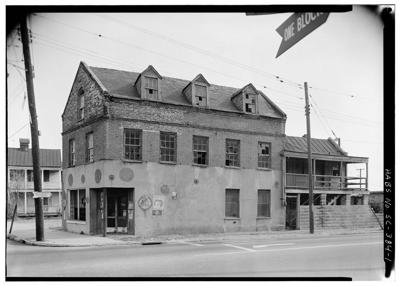From 1996 through the first decade of the 21st century, Charleston’s Committee to Save the City was an outspoken community voice advocating that classical, rather than contemporary, architectural styles should be used when designing new buildings within the city’s historic district. Not everyone agreed, including some among the city’s two principal preservation organizations.
Still, the committee garnered significant public awareness through its annual presentation of the Three Sisters Award, which recognized what it considered exemplary contributions to Charleston’s historic character in ways “that are not appreciated when they are present, but sorely missed when they are gone.”
The award’s name recalls three Charleston single houses that once stood on the southeast corner of Calhoun and East Bay streets. Typical examples of Charleston’s ubiquitous single-house design, no significant historical events ever happened there, nor were they the residences of any renowned persons. They were rentals.
A survey of local newspapers from the time of their construction in the 1840s through their demolition in 1964 revealed only the mundane details of everyday life: rooms for rent, city permitting applications, the occasional petty larceny and addresses in the obituaries of working-class people, both Black and White, who lived there.
Yet despite their ordinariness, or perhaps because of it, the houses at 37, 39 and 41 Calhoun St. often caught the eye of artists whose sketches and watercolors captured the essence of simple, everyday lives of Charleston’s common people.
The ground floor of 41 Calhoun St. was eventually converted into a liquor store; the other two remained residential. All gradually deteriorated from neglect as rentals are wont to do. During a 1961 fire inspection, 37 and 39 Calhoun were condemned as unsafe and slated for demolition.
“During some 200 years the ‘three sisters’ at Calhoun and East Bay have withstood the ravages of time, fire and earthquakes,” decried Preservation Society of Charleston President W.T. Hart in the Evening Post (Feb. 3, 1962). Yet “they cannot withstand the shameful attacks of man.”
The worst part, he said, was that the houses were being demolished not by a greedy developer, but by “the government which was put into office to preserve Charleston.” Citing Rainbow Row and the nearby Gadsden and Primrose houses, Hart encouraged the city to board up the houses until someone could restore them.
“This would be real progress,” he said, “because progress is improving on the old, not destroying it.”
Nevertheless, all three were torn down and replaced by nothing.
In 2021, one of the vacant lots finally saw new life with the construction of a new pharmacy where 41 Calhoun St. had stood. Delta Pharmacy and Medical Supplies has been recognized with both Historic Charleston Foundation’s Whitelaw Founders Award and the Preservation Society of Charleston’s Carolopolis Award for new construction.
In presenting the Whitelaw award, the Historic Charleston Foundation recognized architectural firm Middleton Design Group, saying the new building “took cues from the former 19th century building, but modernized the design with contemporary details … Dissimilar to most new construction projects where developers seek to maximize buildings to their full, allowable zoning envelope, we are impressed that this new building is appropriately scaled to and inspired by traditional Charleston architecture.”
Few walking or carriage tours travel as far north up East Bay Street as its intersection with Calhoun. Still, tourists occasionally will ask to see them.
Not wanting to disappoint their visitors, some have created a new “three sisters” story around a trio of colorful, well-restored houses along lower Meeting Street, claiming they were painted to match the hair colors of three wealthy, but unattractive, sisters whose father built them for his spinster daughters.
Yet they’ll never be the city’s true “three sisters,” whose fate embodies the tragedy of failing to appreciate something until it’s gone.










